
-

Meteor over the Bay of Naples
This photo was taken halfway up Capri Island in the Naples Bay on the evening of February 8, 2024. The camera facing northeast, and middle left of the image is the famous Mount Vesuvius, whose eruption destroyed the entire Pompeii in 79 AD. At this moment, a bright meteor flashed across the sky and headed straight towards Mount Vesuvius. The lights on the horizon come from cities such as Naples, Ercolano, Torre del Greco, and Sorento. The light on the far right of the photo comes from the city of Capri and the pier.
My equipment: Sigma 14mm f1.8 DG HSM, Canon R5. -

2023 Leo Meteor Shower and a Fire Meteor
This photo is the total number of Leonid meteors captured during 2023 Nov 16th to 19th, four nights exposures before and after the maximum value of this year's Leonid meteor shower. These four nights were photoed every night after the rise of Leo at around 11 midnight until the next morning, with a total exposure of about 20 hours. On the far right side of the photo, you can see a very bright Leo meteor, while most meteors are very dim. In the center of the photo, you can see the complete upright Leo constellation.This photo was taken in the suburb of Zhangjiakou, Hebei Province, China.
My equipment: Sigma 28mm f1.4 DG HSM, Nikon D810a. -

2023 Fireworks Orionids Meteors
Every year around October 21st, it is the time for the Orion meteor shower to erupt. This photo records Orion meteors from around October 21st, from the evening of October 18th to October 23rd. After careful selection, I selected approximately 90 meteors from 6 nights for stacking. In the photo, it can be seen that the meteor is emitted from the direction near Orion, emitting a green flame. The smoke generated by the brightest meteor in the photo drifted in the sky for more than five minutes. In the background, you can see the Winter Milky Way, the Orion Large G Nebula, M42 Nebula, and other red nebulae near the Milky Way. This photo was taken in the suburb of Zhangjiakou, Hebei Province, China.
My equipment: Sigma 28mm f1.4 DG HSM, Nikon D810a. -

Perseid Meteor Shower over a Remote Control Observatory
This photo was taken at Aug 12th and 13th night 2023. The image of two nights exposure time recorded the scene of dozens of meteors passing through the sky. The camera's shooting location is located at an observatory that can be remotely controlled. Usually, we use remote control technology to control telescopes to shoot deep space celestial bodies. However, this time, I loaded a DSLR camera with a wide-angle lens onto the telescope and used six mosaic photos to splice panoramic images.
My equipment: Sigma 28mm f1.4 DG HSM, Nikon D810a. -
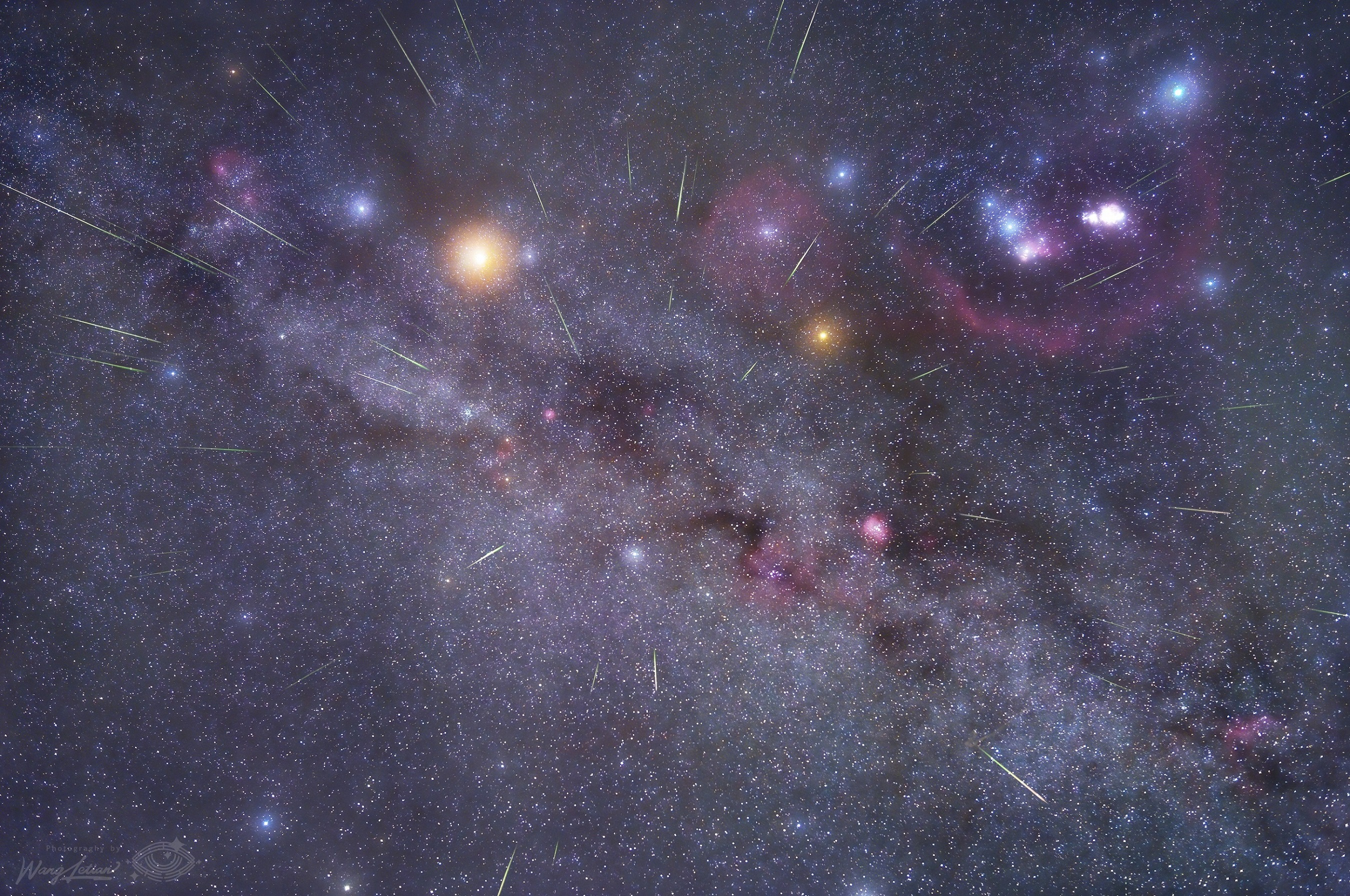
2022 Orionids Meteors with Mars
In late October 2022, the Earth passed through the dense area of the dust belt of Comet Halley, forming the Orion Meteor Shower. This photo was taken in the suburb of Zhangjiakou, Hebei Province, China. The meteors in the picture is stacked by the Orion meteor captured at the night of October 21 and 22, 2022, two nights with an accumulated exposure time of more than 10 hours.The photo recorded about 50 meteors in two nights. The background star sky is composed of 100 pictures obtained when shooting meteors, and the accumulated exposure time is 25 minutes.In this picture, apart from the green radial meteor shower, the orange red Mars is particularly bright.
My equipment: Sigma 28mm f1.4 DG HSM, Nikon D810a. -
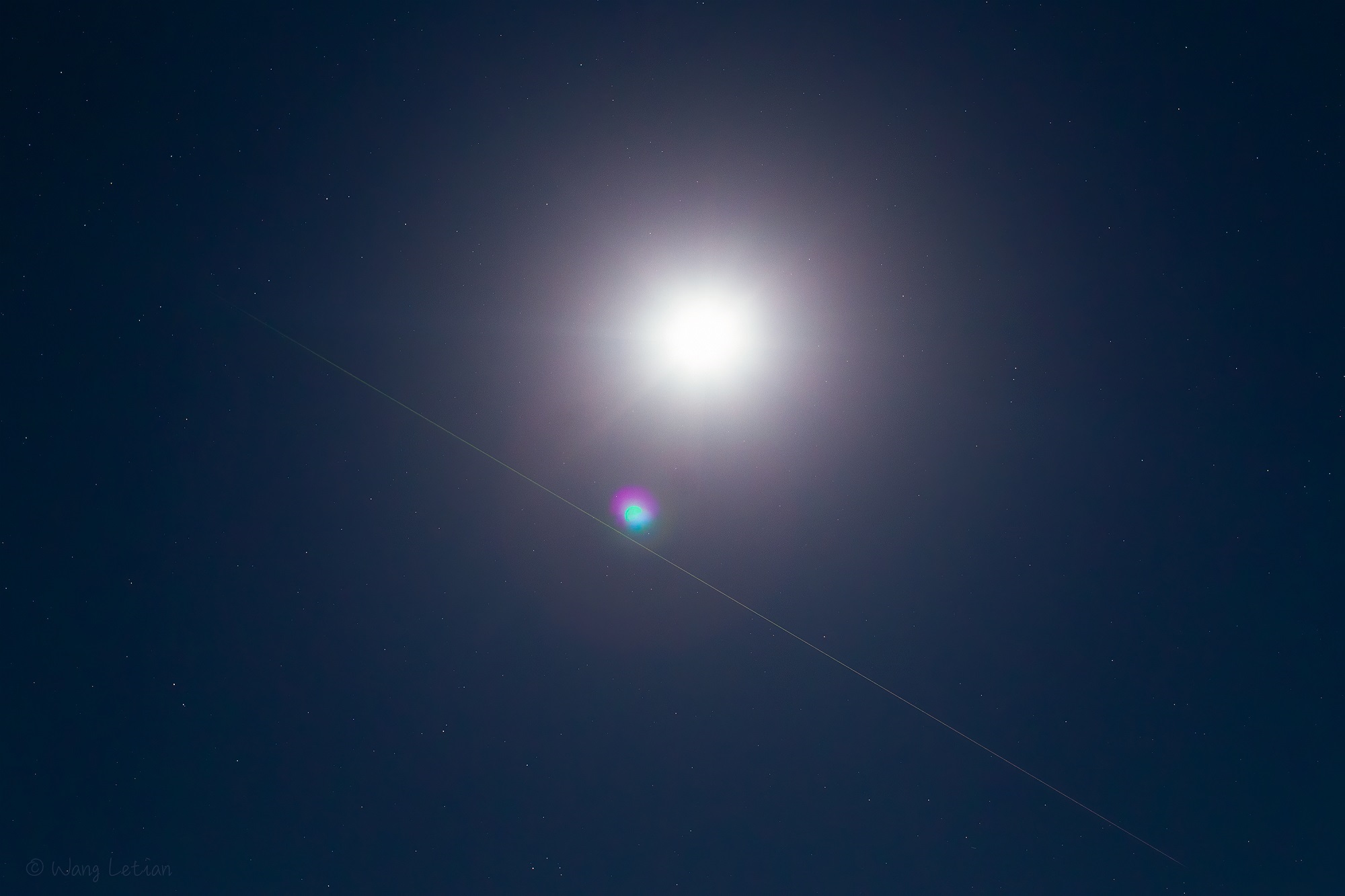
2021 Geminid Meteor against Moonlight
On the evening of December 13, 2021, I captured the meteor with a 50mm fixed focus lens and a canon 6D camera with a single exposure of 2.5 seconds. At that time, a Gemini Meteor passes from the left to the right of the photo, and its color is also from green to orange. from the left to the right of the photo, and its color is also from green to orange.
My equipment: EF 50 f/1.2L Canon 6D. -
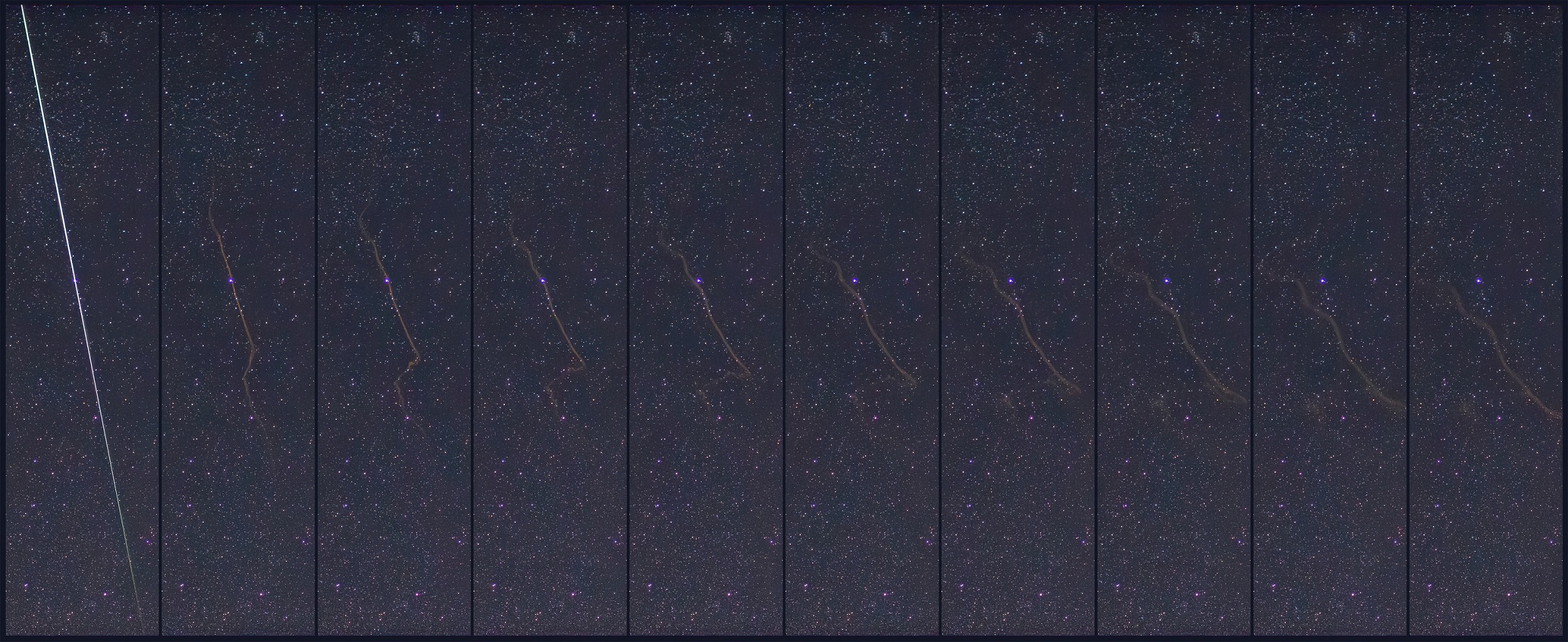
2020 Bright Gemini Meteor and Trail
Before local midnight on December 14 2020, this brilliant Gemini meteor flashed above the suburb of Beijing, China. The meteor streak from bottom right to up-left, passing above a 3 Magnitude star called Adid Australis in Perseus. Red and green light cloud be find in the flash. The bright meteor spans more than 10 degrees.
My equipment: EF 50 f/1.2L Canon 6D. -
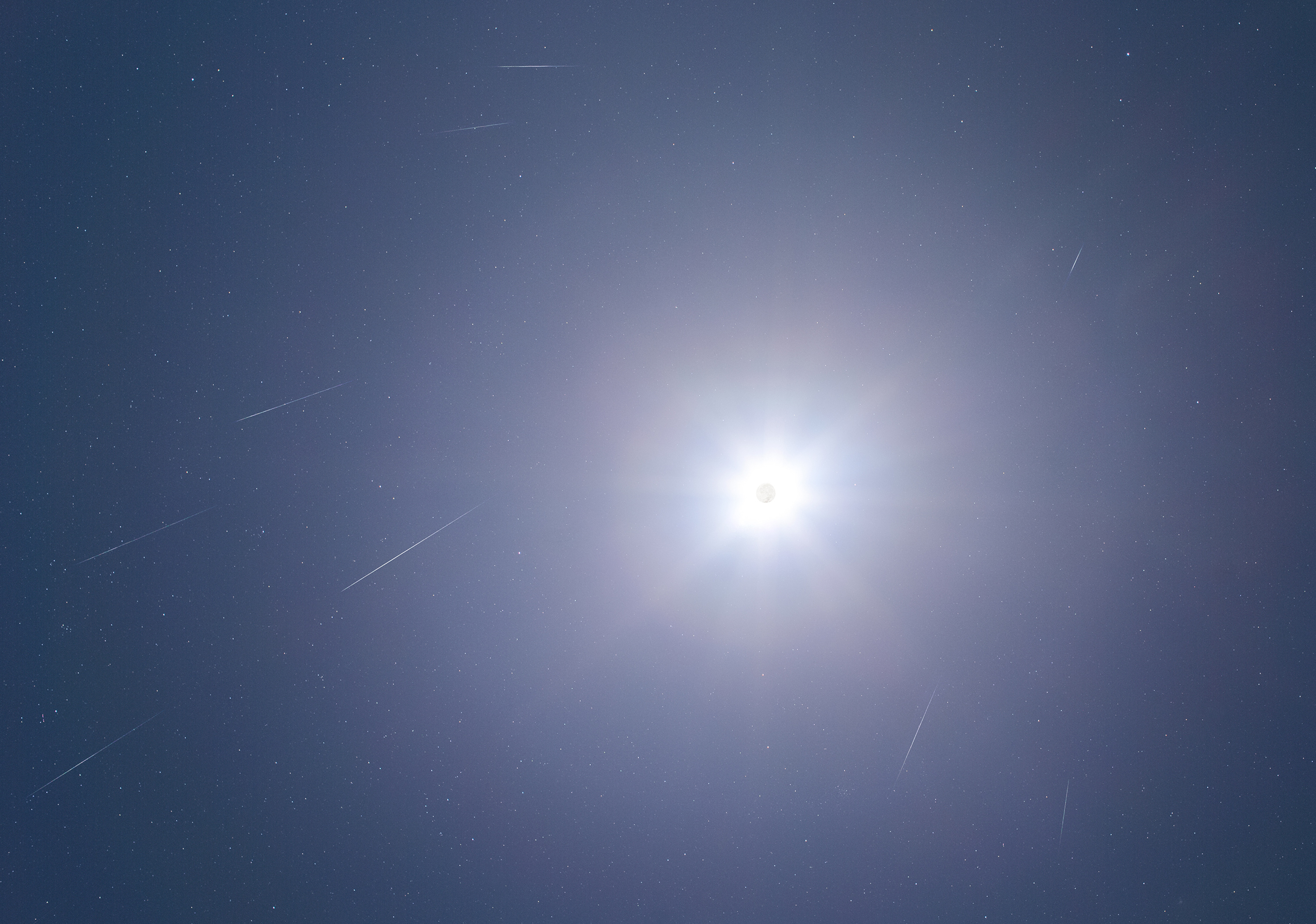
2019 Moon with Geminid Meteors
This photo was taken in the suburb of Beijing, China, from the evening of December 13 to the early morning of December 14, 2019. The exposure time of each photo was 2 seconds, and the whole night's shooting made me get nearly 10000 photos! It is very difficult to find meteors in those image. The shorter exposure time could help me to find the faint meteors hidden in the bright moonlight. Finally, I combined the nine meteors I captured into the final image. The background star image is made up of 100 of the images.
My equipment: EF 50 f/1.2L Canon 6D. -
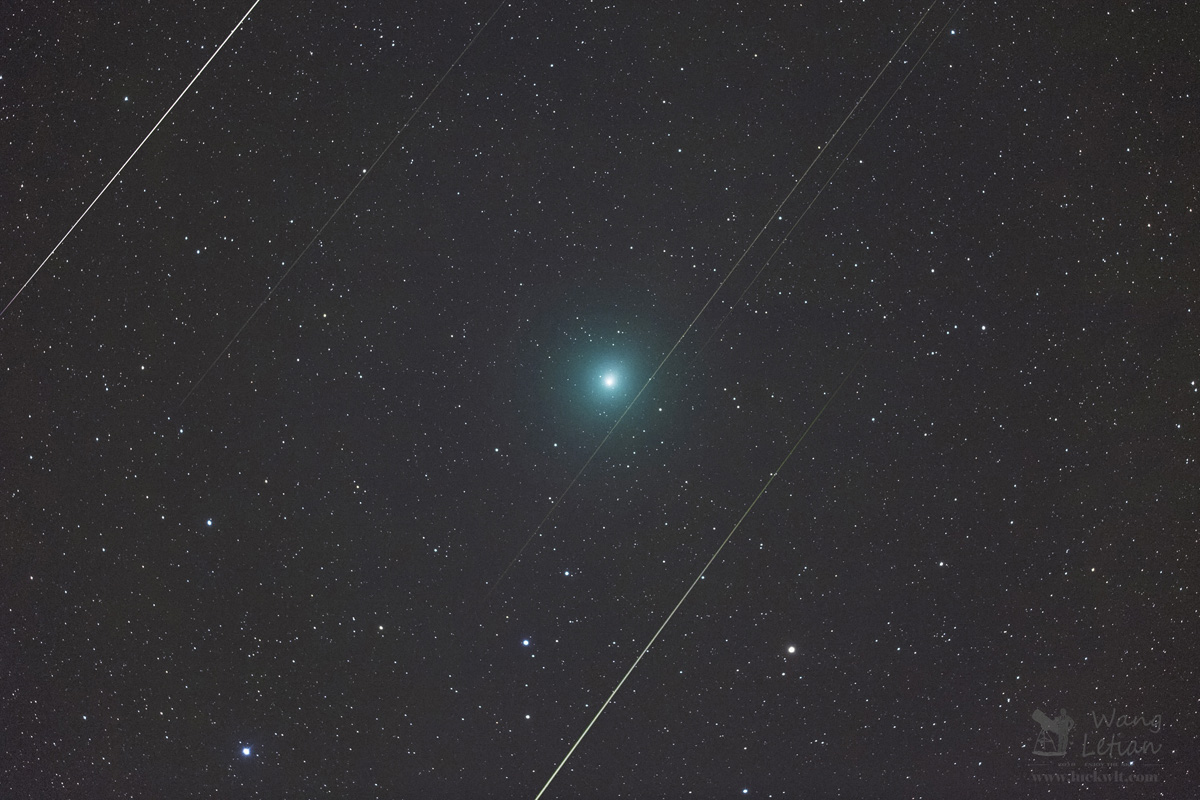
2018 46P and Geminid Meteors
On the morning of December 14, 2018, the night before the Gemini meteor shower reached its maximum, I came to Mentougou District, Beijing, where I was waiting for the Gemini meteor shower. Comet 46P happened to be in the best observation period these days. I goto my telescope to the comet. In four hours, five Gemini meteors were recorded in front of the comet. The meeting of comets and meteors may be a rare encounter in the universe.
My equipment: FS 60CB telescope with zoom lens, equivalent focal length 256 mm; Nikon D810a, exposure 10 seconds, ISO10000. -

2017 Geminid Meteors in Winter
2017 December 13th, I came to a northeast city, TongLiao, Inner Mongolia, China. It is clear but very cold. The temperature is minus 20 degree. More than five hours exposure time record more than fifty meteors. There are some fireballs in the image and a persistent train could be find at the left. In addition, the winter constellation, airglow and milkyway is also visible. There are some equipment in the front of me which is used to get meteors in different dirction.
My equipment is Nikon D810a and AS-F 14-24mm f2.8 lens @ 14mm. I composed more than 50 images to the final picture. -

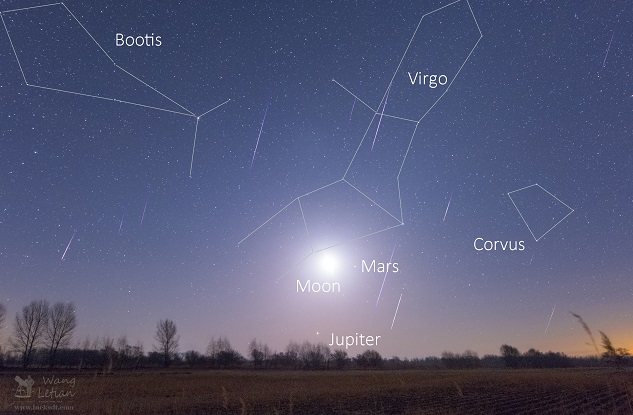
2017 Moon Rises Meteors Fall
Less than one hour exposure time record more than ten meteors. Before sunrise, the old moon rises. My image shows the moon rises, at the same time, the meteors fall. In additon, Mars and Jupiter are bright and can be found above the east horizon.
My equipment is Nikon D810a and AS-F 14-24mm f2.8 lens @ 14mm. I composed 15 images to the final picture. -
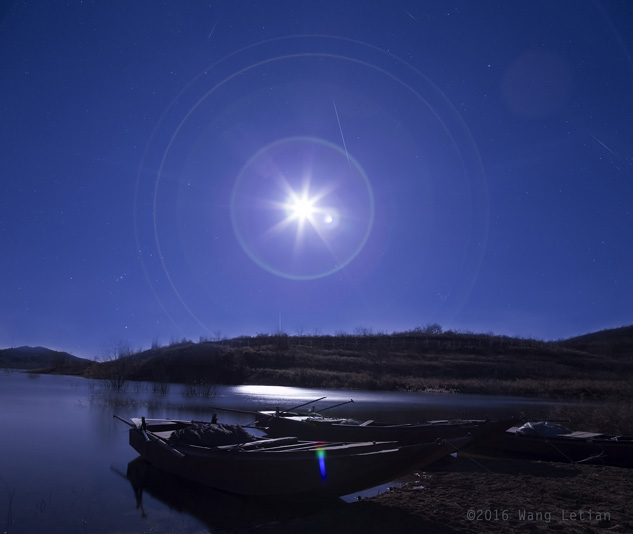
2016 Geminid Meteors with Full Moon
At December 13th night 2016, I spent about four hours to get the Geminid Meteors image. I came to Miyun Reservoir in the northeast suburb of Beijing, China. I used a Canon 6D with lens of EF 24 1.4L II to record about several meteors in this image. The moon in the middle, it is very bright and only brigher meteros could be seen. In addition, the glow of the moon and other background star could be visible in this image.
This image was published on APOD website.(http://apod.nasa.gov/apod/ap161216.html) -
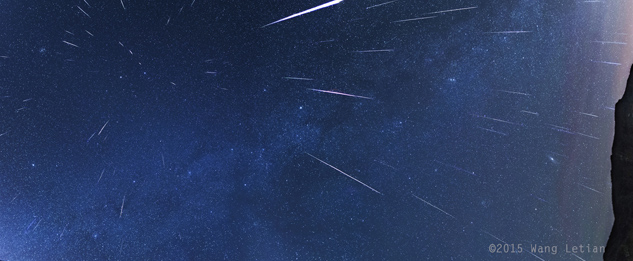
2015 Geminid Meteor in Milky Way
At December 14th night 2015, I spent about three hours to get the Geminid Meteors image. I came to Tang Hekou, a small town in the north suburb of Beijing, China. I used two Canon 6D and two lens of EF 24 1.4L II to record about 80 to 90 meteors in this image. I choose them form several thousands images. Finally, the image range is more than 100 degree from the left to the right. Lots of deep sky objects could be seen from left to right: M44 M35 Double Cluster and M31. The color of the airglow can also be seen in the right. -

2015 Perseid Meteors Shower Bursting
This image was captured in the mountain area in the west of Beijing, China. About 80 meteors was recorded from 15:00 UT to 20:00 UT in August 12th 2015. Most of them are from Perseus. High ISO lead to more noise, however, more dark meteors could be captured. Double cluster, M31, M34 could be seen clearly. I used Canon EF 24mm 1.4L II with Canon 6D to get them. -
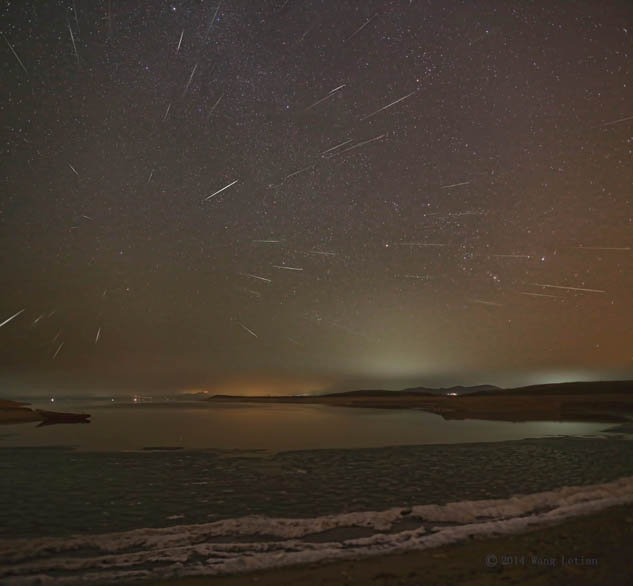
2014 Geminid Meteors over Ice Lake
At 2014 December 13th night about 24 hours before the max value of Geminid Meteors, I came to Mi Yun Reservoir in the suburb of Beijing to observe the Meteors. Although the temperature is below zero and the lake is freeze, I am excited and warm because the fantastic meteors. I used my Canon 6D and EF 24 1.4L II lens to record about 60 meteors in five hours (from 9pm to 2 am) and more than 50 meteors are Geminid! As my image shows, the Gemind Meteors are bursting out from the radiant point over the ice lake. I composed about 54 meteors in this picture.(Other meteors are not be composed in) The moon rise about 12 o’clock and after that, the meteors is difficult to capture due to the moon light.
Wang Letian All Rights Reserved